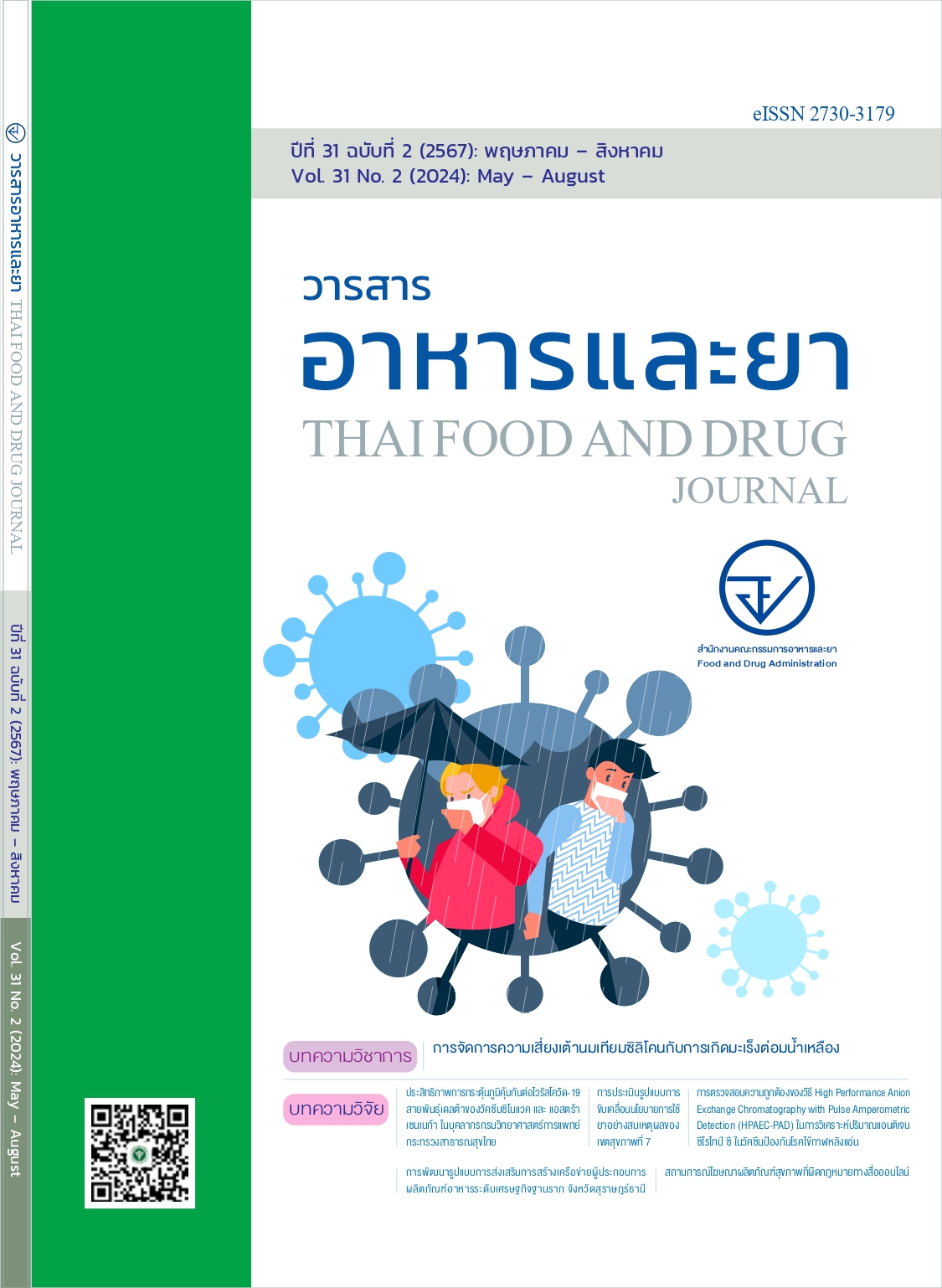สถานการณ์โฆษณาผลิตภัณฑ์สุขภาพที่ผิดกฎหมายทางสื่อออนไลน์
Main Article Content
บทคัดย่อ
ความสำคัญ: คนไทยในปัจจุบันมีพฤติกรรมการใช้อินเทอร์เน็ตเพื่อการติดต่อสื่อสาร สนทนา ทำธุรกรรมซื้อขายสินค้าและบริการเป็นจำนวนมาก การโฆษณาขายสินค้าผลิตภัณฑ์สุขภาพออนไลน์ทำได้ง่ายโดยใช้กลยุทธ์สื่อสารโฆษณา ขณะที่สำนักงานคณะกรรมการอาหารและยามีกฎหมายควบคุมและเฝ้าระวังการโฆษณา แต่พบการโฆษณาที่ผิดกฎหมาย เช่น การกล่าวอ้างสรรพคุณโอ้อวดเกินจริง ซึ่งทำให้ผู้บริโภคตกเป็นเหยื่อและอาจได้รับอันตรายจากสินค้าที่ไม่ปลอดภัยได้
วัตถุประสงค์: งานวิจัยนี้มีวัตถุประสงค์เพื่อสำรวจโฆษณาและค้นหาผลิตภัณฑ์สุขภาพที่ผิดกฎหมายที่จำหน่ายหรือเผยแพร่ผ่านช่องทางออนไลน์ โดยบันทึกลงระบบแอปพลิเคชันตาไวฟอร์เฮลท์ รุ่น 3.0 (TaWai for Health (Version 3.0))
วิธีการวิจัย: เป็นการวิจัยเชิงพรรณนา ดำเนินการในช่วง เดือน เมษายน-พฤษภาคม 2566 โดยนักศึกษาคณะเภสัชศาสตร์ชั้นปีที่ 3 มหาวิทยาลัยเชียงใหม่ ที่ผ่านการอบรมความรู้ด้านการโฆษณาผลิตภัณฑ์และการรายงานเข้าสู่ระบบ TaWai for Health (Version 3.0) เป็นผู้ลงรายงาน ข้อมูลที่ได้จากการรายงานจะถูกวิเคราะห์สังเคราะห์และนำเสนอในรูปแบบสถิติเชิงพรรณนา
ผลการศึกษา: จากผลการศึกษาพบว่า มีการโฆษณาผลิตภัณฑ์สุขภาพผิดกฎหมายบนสื่อออนไลน์ ทั้งหมด 979 รายงาน พบร้านค้าที่มีการโฆษณาผิดกฎหมายผ่านแพลตฟอร์ม eCommerce A มากที่สุด ร้อยละ 58.02 รองลงมาคือ Social network A ร้อยละ 31.15 และ eCommerce B ร้อยละ 7.15 ในจำนวนรายงานที่พบกระทำผิดทั้งหมดสามารถจำแนกประเภทผลิตภัณฑ์สุขภาพที่ผิดกฎหมายสูงสุด ได้แก่ เครื่องสำอาง ร้อยละ 51.69 รองลงมาเป็นผลิตภัณฑ์อาหาร ร้อยละ 40.35 (ผลิตภัณฑ์เสริมอาหาร และผลิตภัณฑ์อาหาร ร้อยละ 40.35 และ 2.86) ผลิตภัณฑ์สมุนไพร ผลิตภัณฑ์ยา และอื่น ๆ ร้อยละ 2.86, 2.55 และ 0.20 ตามลำดับ เมื่อจำแนกการอวดอ้างสรรพคุณพบว่า มีการโฆษณาสรรพคุณทำให้ผิวขาว กระจ่างใส มากที่สุด ร้อยละ 33.64 รองลงมา คือรักษาโรค ร้อยละ 15.56 ลดสิว ฝ้า และจุดด่างดำ ร้อยละ 12.22 ลดน้ำหนัก ร้อยละ 11.92 ขยายหน้าอกและบำรุงอวัยวะเพศหญิง ร้อยละ 11.11 และเสริมสมรรถภาพทางเพศชาย ร้อยละ 7.68
สรุป: สถานการณ์การโฆษณาผลิตภัณฑ์สุขภาพทางสื่อออนไลน์จากแหล่งที่นิยมของผู้ใช้ในประเทศไทยในการศึกษานี้พบว่า ผลิตภัณฑ์ที่มีการโฆษณาที่ผิดกฎหมายมากที่สุด 2 อันดับแรก คือเครื่องสำอางที่ส่วนใหญ่ชวนเชื่อเรื่องสรรพคุณผิวขาวและลดสิวฝ้า และผลิตภัณฑ์เสริมอาหารซึ่งส่วนใหญ่ชวนเชื่อเรื่องการลดน้ำหนักและการเสริมสมรรถภาพทางเพศ ดังนั้น เพื่อแก้ไขและจัดการปัญหาดังกล่าว สำนักงานคณะกรรมการอาหารและยาควรจัดทำระบบเว็บไซต์ขึ้นเป็นการเฉพาะ บูรณาการภาครัฐเครือข่ายและประชาชนร่วมเฝ้าระวัง รวมทั้งเพิ่มมาตรการความร่วมมือเจ้าของหรือผู้ดูแลแพลตฟอร์มออนไลน์ให้เป็นผู้คัดกรองผู้จำหน่ายผลิตภัณฑ์และข้อความโฆษณาเบื้องต้นก่อนอนุญาตโฆษณาบนแพลตฟอร์ม
Article Details

อนุญาตภายใต้เงื่อนไข Creative Commons Attribution 4.0 International License.
เอกสารอ้างอิง
กระทรวงดิจิตอลเศรษฐกิจเพื่อสังคม (ETDA). รายงานผลสำรวจพฤติกรรมการผู้ใช้อินเตอร์เน็ตในประเทศไทย ปี 2565 [อินเทอร์เน็ต].กรุงเทพฯ: กระทรวงดิจิตอลเศรษฐกิจเพื่อสังคม (ETDA);2565 [เข้าถึงเมื่อ 1 พ.ย. 2566]. เข้าถึงได้จาก: https://www.etda.or.th/getattachment/78750426-4a58-4c36-85d3-d1c11c3db1f3/IUB-65-Final.pdf.aspx
ศูนย์จัดการเรื่องร้องเรียนและปราบปรามการกระทำผิดกฎหมายเกี่ยวกับผลิตภัณฑ์สุขภาพ (ศรป.). สถิติการเฝ้าระวังโฆษณาของสำนักคณะกรรมการอาหารและยา [อินเทอร์เน็ต].กรุงเทพฯ: สำนักงานคณะกรรมการอาหารและยา; 2566 [เข้าถึงเมื่อ 25 พ.ย. 2566]. เข้าถึงได้จาก: https://cemc.fda.moph.go.th/statistic/category/advertising-statistics/
พนิตนาฏ คำนุ้ย. การโฆษณาขายยาออนไลน์ที่ผิดกฎหมายและมาตรการดำเนินการ [อินเทอร์เน็ต]. กรุงเทพฯ: กองยา สำนักงานคณะกรรมการอาหารและยา; 2562 [เข้าถึงเมื่อ 1 พ.ย. 2566]. เข้าถึงได้จาก:https://plan.fda.moph.go.th/media.php?id=534211140662730752&name=binder18561.pdf
เมษยา ปานทอง. ประสิทธิผลของระบบการจัดการเรื่องร้องเรียนด้านโฆษณาเกี่ยวกับผลิตภัณฑ์สุขภาพทางอินเทอร์เน็ต [อินเทอร์เน็ต]. กรุงเทพฯ: กองส่งเสริมงานคุ้มครองผู้บริโภคด้านผลิตภัณฑ์สุขภาพในส่วนภูมิภาคและท้องถิ่น; 2563 [เข้าถึงเมื่อ 1 พ.ย. 2566]. เข้าถึงได้จาก: http://ithesis-ir.su.ac.th/dspace/bitstream/123456789/3358/1/60362306.pdf
สุชัญญา พลเพชร. การกำกับดูแลการโฆษณาผลิตภัณฑ์เสริมอาหารทางอินเทอร์เน็ต. วารสารวิจัยและพัฒนาระบบสุขภาพ [อินเทอร์เน็ต].2563 [เข้าถึงเมื่อ 1 พ.ย. 2566]; 13(2): 631-32. เข้าถึงได้จาก: https://he02.tcithaijo.org/index.php/RDHSJ/article/view/255137
ศูนย์ข้อมูลเฝ้าระวังระบบยา.แนวทางการจัดการปัญหาโฆษณาบนสื่อออนไลน์และสื่อต่าง ๆ. ยาวิพาษณ์ [อินเทอร์เน็ต].2562 [เข้าถึงเมื่อ 1 พ.ย. 2566]; 10(40): หน้า 36-37 เข้าถึงได้จาก:https://www.thaidrugwatch.org/download/series/series40.pdf
สำนักสารนิเทศ สำนักงานปลัด กระทรวงสาธารณสุข. การแถลงผลการทลายแหล่งขายสมุนไพร ยาผงจินดามณี (ยาผีบอก) [อินเตอร์เน็ต].กรุงเทพฯ: สำนักสารนิเทศ สำนักงานปลัดกระทรวงสาธารณสุข;2563 [เข้าถึงเมื่อ 1 พ.ย. 2566]. เข้าถึงได้จาก: https://pr.moph.go.th/?url=pr/detail/2/02/147183/
กลุ่มพัฒนาเครือข่าย กองพัฒนาศักยภาพผู้บริโภค สำนักงานคณะกรรมการอาหารและยา .คู่มือการตรวจสอบเฝ้าระวังโฆษณาผลิตภัณฑ์สุขภาพเบื้องต้น.พิมพ์ครั้งที่ 6 :กรุงเทพ: โรงพิมพ์สำนักงานพระพุทธศาสนาแห่งชาติ;2559.
สำนักคณะกรรมการอาหารและยา กระทรวงสาธารณสุข [อินเทอร์เน็ต].กรุงเทพฯ: สำนักคณะกรรมการอาหารและยา กระทรวงสาธารณสุข;2563 [เข้าถึงเมื่อ 4 มิ.ย.2567]. เข้าถึงได้จาก: https://www.fda.moph.go.th/law-fda/
สำนักงานคณะกรรมการอาหารและยา. เตือนภัยผลิตภัณฑ์สุขภาพผิดกฎหมาย. [อินเตอร์เน็ต].กรุงเทพฯ: สำนักคณะกรรมการอาหารและยา กระทรวงสาธารณสุข; 2565 [เข้าถึงเมื่อ 4 มิ.ย.2567]. เข้าถึงได้จาก:
https://oryor.com/media/newsUpdate/media_news/2186?ref=search
กองอาหาร สำนักงานคณะกรรมการอาหารและยา. แจ้งเตือนผู้บริโภค [อินเทอร์เน็ต].กรุงเทพฯ: สำนัก
คณะกรรมการอาหารและยา กระทรวงสาธารณสุข; 2564 [เข้าถึงเมื่อ 4 มิ.ย.2567]. เข้าถึงได้จาก:
https://food.fda.moph.go.th/consumer-alertnews/food-safety-news-039/


